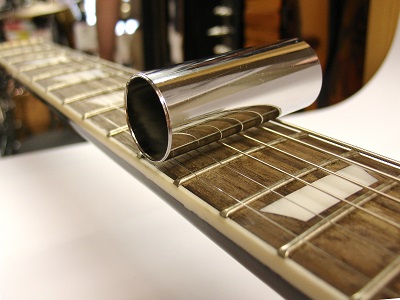Slide Guitar Basics And How to Do It Right
 Whether you want to play bluegrass, country, the blues, or even just experiment with a new way of playing, slide guitar is a fun way to expand your musical horizons. Slides are easy, cheap, and effective ways of blending your notes together seamlessly because –let’s face it—we can’t all afford fretless guitars.
Whether you want to play bluegrass, country, the blues, or even just experiment with a new way of playing, slide guitar is a fun way to expand your musical horizons. Slides are easy, cheap, and effective ways of blending your notes together seamlessly because –let’s face it—we can’t all afford fretless guitars.
In this article, we will go over the basics of slide guitar so that you can start to build your foundation.
The first thing that you need to consider when playing slide guitar is the slide itself. There are two types of basic slides; steel and glass.
What Are The Differences Between the Materials?
While they are, for the most part, made evenly enough so that they both perform within the same class, the difference is all about tone. Glass slides have a brighter tone while steel slides tend to have a somewhat darker tone. While the steel does carry the note throughout its frame, the glass tends to resonate the note more clearly.
Choosing a slide shouldn’t be a life or death decision; it won’t make enough of a difference to affect your overall playing to worry too much, just keep in mind that glass is a bit brighter while steel is a bit darker.
Once you have chosen your slide, you need to consider which finger to wear it on. Primarily, you have three options; the index finger, the middle finger, and the ring finger. It is best to avoid using the pinky as it is a weaker digit and it will be the furthest from any fretted notes. The index finger and middle finger are the most popular choices. Make your choice depending on your goal; do you want to slide full chords or do you want to slide notes?
Full Chords Require Good Finger Control And Strength
If you want to slide full chords, it is best that you use the index finger and focus on barre chords. If you want to use single notes, choose whichever finger feels the most comfortable.
When sliding with a slide on your finger, you want to keep pressure on the strings. If you are playing on the treble strings, you don’t want to try and compensate pressure; you want to move your finger a bit farther down so that it covers the treble strings only. This is made possible as slide guitar isn’t meant to be fast. This means that you won’t be rushing to fret a complex chord after your slide, so you can relax a bit when fretting.
If You Don’t Use It, You Will Lose It
The best way to perfect your slide guitar technique is to practice. Make slide guitar a full part of your daily practice routine. Try working on chord shapes and allow your fingers to get used to fretting, especially the finger wearing the slide, as it will feel awkward at first.
It takes less pressure to fret with a slide, so it is common for your fingers to feel unbalanced at first. The more you get used to slide guitar, the more natural it will feel. Take your time and be patient. Have fun, but stick to your scheduled practice routine. Good luck!







Leave A Comment